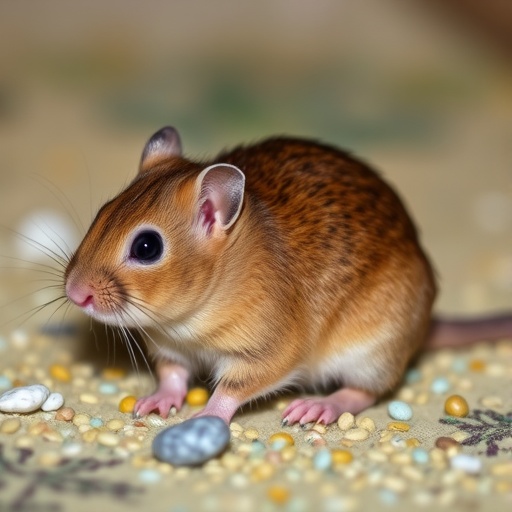A recent breakthrough study published in Acta Parasitologica sheds new light on the enigmatic relationship between parasitic infections and neurological disorders, specifically exploring the physiological and behavioral consequences of Onchocerca ochengi infection in gerbils. This research offers a compelling experimental foundation for understanding onchocerciasis-associated epilepsy (OAE), a debilitating condition affecting thousands in endemic regions across Africa but one that remains poorly understood at the mechanistic level. By harnessing an animal model closely related to the human disease pathway, this study paves the way for innovative therapeutic avenues and deepens our grasp of parasite-host interactions affecting the nervous system.
Onchocerciasis, commonly known as river blindness, is caused primarily by the parasitic worm Onchocerca volvulus. However, Onchocerca ochengi, a closely related filarial parasite infecting cattle, presents an analogous model system to study host responses due to its genetic and antigenic similarities. Researchers have leveraged gerbils as a surrogate host organism to model infection dynamics and resultant pathologies. Gerbils infected with O. ochengi show profound physiological perturbations and behavioral abnormalities, mirroring aspects of the human syndrome—an intersection that holds key insights for tackling OAE.
The experimental design centered on introducing infective larvae of O. ochengi into the gerbil hosts, followed by longitudinal monitoring of physiological parameters such as immune response, parasite burden, and neurological alterations. Behavioral analyses included assessments of locomotor activity, anxiety-like behaviors, and seizure susceptibility under controlled conditions. These comprehensive methodologies enabled the team to capture a multifaceted portrait of the infection’s progression and its systemic impact, beyond mere parasitic colonization.
.adsslot_zifodmPUMT{ width:728px !important; height:90px !important; }
@media (max-width:1199px) { .adsslot_zifodmPUMT{ width:468px !important; height:60px !important; } }
@media (max-width:767px) { .adsslot_zifodmPUMT{ width:320px !important; height:50px !important; } }
ADVERTISEMENT
One of the study’s cornerstone findings is the observation of heightened neuroinflammation in infected gerbils, as evidenced by elevated microglial activation and pro-inflammatory cytokine expression within brain tissue. This neuroinflammatory milieu is critical because it has been previously implicated in epileptogenesis and other neurodegenerative disorders. The localized inflammatory responses suggest a mechanistic link whereby parasitic antigens or by-products could disrupt neural homeostasis, triggering aberrant electrical activity and seizure generation.
Immunological profiling revealed a skewing towards a Th2-dominant response, characterized by elevated levels of interleukins IL-4 and IL-10, alongside suppressed Th1 markers. This immune polarization could facilitate parasite survival while concurrently compromising other immune defense mechanisms, allowing chronic infection and prolonged host tissue damage. Chronic immune activation, particularly when sustained in neural environments, can exacerbate tissue pathology and contribute to ongoing neurological dysfunction.
Significantly, the parasitic infection was shown to disrupt the blood-brain barrier (BBB) integrity in gerbils, a critical finding linking peripherally localized infections to central nervous system consequences. The compromised BBB likely permits infiltration of inflammatory cells and pathogen-derived molecules into the brain parenchyma, inciting further neuroinflammation and neuronal distress. This vascular breach represents a pivotal pathophysiological event bridging parasitic invasion to seizure disorders.
The research also delves into parasitic load dynamics, demonstrating that higher worm burdens correlate positively with more severe behavioral impairments and intensified neuroinflammation. This dose-dependent effect provides a quantifiable marker for assessing disease severity and prognostication in natural infections. Monitoring parasite load in endemic populations could thus inform risk stratification for neurological complications, particularly epilepsy development.
From a methodological perspective, this study incorporated advanced imaging techniques, including immunohistochemistry and in vivo fluorescence microscopy, to visualize parasite localization and immune cell infiltration. These technologies offered unprecedented clarity into spatial and temporal aspects of infection-induced neuropathology. The integration of neurobehavioral testing with molecular and histological data sets a new standard for multidisciplinary parasitology research.
Moreover, the findings highlight potential molecular targets for therapeutic intervention. For instance, modulating microglial activation or restoring BBB integrity could mitigate neuroinflammatory damage and prevent seizure onset. Similarly, shifting immune profiles away from detrimental Th2 dominance could facilitate parasite clearance without excessive collateral neural injury. This translational potential transforms the study from an observational account to a roadmap for clinical strategies.
This study’s significance amplifies when considering the socioeconomic context of onchocerciasis-endemic regions, where epilepsy heavily burdens affected communities, particularly children. By elucidating infection-driven neuropathological mechanisms, the research advocates for integrated disease management approaches combining antiparasitic measures with neurological care. Such holistic frameworks are essential to improving quality of life and reducing disability in these vulnerable populations.
In sum, the detailed characterization of Onchocerca ochengi infection in gerbils reveals critical insights into how filarial parasites may induce neurological sequelae analogous to human onchocerciasis-associated epilepsy. The dual focus on behavioral outcomes and neuroimmune mechanisms highlights the intricate host-pathogen interplay shaping disease manifestations. This animal model stands as a robust platform enabling further dissection of underlying biological pathways and evaluation of novel interventions.
Looking forward, expansion of this research to include longitudinal studies assessing the temporal progression from infection to chronic neurological impairment will be invaluable. Additionally, exploring genetic susceptibility factors within the host and parasite could unravel individual variability influencing disease severity. There is also promise in investigating co-infections and environmental factors that exacerbate neuropathology in endemic settings.
In conclusion, this pioneering study bridges a critical knowledge gap by experimentally modeling neurobehavioral consequences of filarial infection using O. ochengi-infected gerbils. The evidence strongly implicates neuroinflammation and BBB disruption as key mediators of infection-induced epilepsy, affirming the pathological relevance of parasitic infections beyond conventional symptomatology. As such, it redefines parasitic disease research at the nexus of immunology, neurology, and behavioral science, forging a path towards impactful therapeutic breakthroughs.
Subject of Research: Physiological and behavioral effects of Onchocerca ochengi infection in gerbils and its implications for onchocerciasis-associated epilepsy research.
Article Title: Physiological and Behavioral Effects of Onchocerca ochengi Infection in Gerbils: Implications for Onchocerciasis-Associated Epilepsy Research.
Article References:
Ayiseh, R.B., Anangafack, F.U., Etaka, J.C. et al. Physiological and Behavioral Effects of Onchocerca ochengi Infection in Gerbils: Implications for Onchocerciasis-Associated Epilepsy Research. Acta Parasit. 70, 176 (2025). https://doi.org/10.1007/s11686-025-01105-z
Image Credits: AI Generated
Tags: animal model for neurological disordersexperimental parasitologygerbil behavioral changesgerbils as surrogate hostshost-parasite interactionsinnovative therapeutic approachesOnchocerca ochengi infectiononchocerciasis-associated epilepsyparasitic worm impact on hostsphysiological effects of parasitic infectionsriver blindness researchunderstanding neurological disorders in endemic regions





